10 August 1778 Monday
The pain has mostly subsided, but rest is still necessary. Did a little bit of writing...
Pompeii, famous city, buried in its entirety in the seventy-ninth year of the Christian era, the only city to emerge from its rubble: public roads, walls, city gates, tombs, temples, chapels, theatres, amphitheaters, exercise halls, schools, baths, townhouses and countryside, the casernes, the various ornaments in stucco, terracotta, marble, paintings, arabesques, mosaics; successive discoveries will even make known the public and private uses, and even the foodstuffs preserved by petrification.
Three volumes, containing 160 plates
The text or explanation, in one volume, with observations relating to art. Everything relating to erudition will be drawn from classical authors, such as Tacitus, Pliny, Cicero, Pausanias, Polybius, etc.
Artifacts of the Bianconi vs Piranesi 'Circus of Caracalla' affair 1772-1789
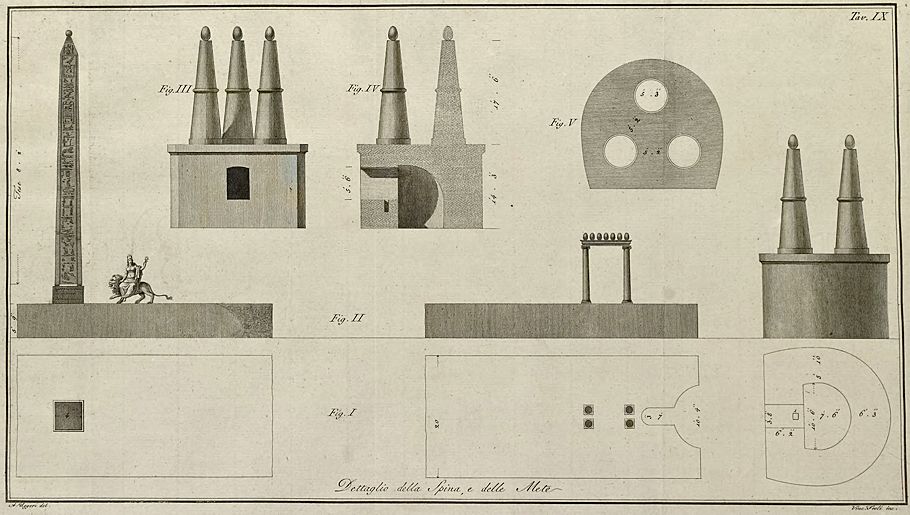
Tavola IX Detail of the Spina, and of the Metae.
Fig. I Plan of the spine, and of the small temple.
Fig. II Elevation of the spine.
Fig. III Prospectus of the metae.
Fig. IV Cutaway of the same.
Fig. V Plan of metae.
...
Did some research into Angelo Uggeri, the delineator of the above print and most of the prints within Descrizione dei circhi, particolarmente di quello di Caracalla e dei giochi in esso celebrati, 1789.
...
La carriera di Uggeri si andava delineando autonomamente: dall’esecuzione di disegni non meglio specificati per i palazzi Borromeo d’Adda su corso Manzoni e Vidani a porta Orientale (De Boni, 1840), allo studio degli ordini, da cui maturň «il pensiero di pubblicare un libro che contenesse un trattato di tre ordini, come libro elementare di Architettura» (Uggeri, 1823, p. 296), e con esso l’idea di un soggiorno di studio a Roma, messa in atto nel 1788.
Secondo le fonti biografiche, il principale fautore del trasferimento di Uggeri a Roma fu il conte Gian Rinaldo Carli, uomo politico ed erudito antiquario, conosciuto nello studio di Bianconi. Grande estimatore dei suoi studi sull’ordine dorico, costui ne pubblicň alcuni disegni del Colosseo, non firmati (Carli, 1788), che il maestro ritenne frutto di plagio delle proprie ricerche e di quelle del fratello Gian Ludovico, morto nel 1781. Bianconi imputň tale plagio alla condotta sleale di Uggeri in una lettera scrittagli il 18 febbraio 1789: «Ho saputo poi ch’Ella gli ha fatto i disegni senza dirmene una parola, come doveva. Cosa debbo dirle se non che, quod tibi non vis, alteri ne feceris. I dolori maggiori mi sono venuti dal far bene ad altri. Non per questo lascierň il mio cammino. Ella mi dee intendere... Stia bene, si faccia onore, ma non cosě» (P. F., 1802, p. XXII).
La lettera di Bianconi fu pubblicata nel 1802 all’interno della prefazione della versione originale della Descrizione dei circhi particolarmente di quello di Caracalla... del fratello Gian Ludovico. Questo testo, firmato da un non meglio identificato P. F., ma evidentemente ispirato dallo stesso Carlo (morto il 15 agosto di quell’anno), conteneva altre veementi accuse a Uggeri per avere curato, insieme all’archeologo Carlo Fea, la prima edizione dell’opera di Gian Ludovico nel 1789, millantando la totale revisione dei disegni che l’autore aveva commissionato nel 1772 a un architetto imprecisato, recentemente identificato in Pierre-Adrien Pâris, allora pensionnaire dell’Académie de France, il quale a sua volta accusň Uggeri di plagio (Pinon, 2007).
Anche se effettivamente la pianta del circo di Massenzio, allora detto di Caracalla, pubblicata da Uggeri ricalcava quella di Pâris, le sue ricostruzioni degli alzati erano sostanzialmente diverse, e denotavano il primo esito della febbrile attivitŕ di studio delle antichitŕ che da subito lo indusse a stabilirsi definitivamente a Roma.
--Tommaso Manfredi
Uggeri's career was taking shape autonomously: from the execution of unspecified drawings for the Borromeo d'Adda palaces on Corso Manzoni and Vidani a porta Orientale (De Boni, 1840), to the study of orders, from which he matured "the thought of publishing a book containing a treatise of three orders, as an elementary book of Architecture" (Uggeri, 1823, p. 296), and with it the idea of a study stay in Rome, implemented in 1788.
According to biographical sources, the main proponent of Uggeri's transfer to Rome was Count Gian Rinaldo Carli, a politician and erudite antiquarian, known in [Carlo] Bianconi's studio. A great admirer of his studies on the Doric order, he published some unsigned drawings of the Colosseum (Carli, 1788), which the master believed to be the result of plagiarism of his own research and those of his brother Gian Ludovico, who died in 1781. Bianconi attributed this plagiarism to Uggeri's disloyal conduct in a letter written to him on February 18, 1789: "I learned then that you made the drawings without saying a word, as you should. What must I tell you except that, quod tibi non vis, alteri ne feceris. The greatest pains came from doing good to others. I will not leave my path. She dee me understand... Be well, let it be honored, but not like this" (P. F., 1802, p. XXII).
Bianconi's letter was published in 1802 in the preface of the original version of the Description of the circuses, particularly that of Caracalla... by his brother Gian Ludovico. This text, signed by an unidentified P. F., but evidently inspired by Carlo himself (who died on August 15 of that year), contained other vehement accusations against Uggeri for having edited, together with the archaeologist Carlo Fea, the first edition of Gian Ludovico's work in 1789, boasting the total revision of the drawings that the author had commissioned in 1772 to an unspecified architect, recently identified as Pierre-Adrien Pâris, then pensionnaire of the Académie de France, who in turn accused Uggeri of plagiarism (Pinon, 2007).
Although indeed the plan of the circus of Maxentius, then called Caracalla, published by Uggeri followed that of Pâris, his reconstructions of the raised were substantially different, and denoted the first outcome of the feverish activity of study of antiquities that immediately led him to settle permanently in Rome.
...
"Legrands says the Piranesi instructed Francesco in Roman history and the Latin language as soon as he could draw. He was sent to study at the French Academy and was destined for the church but, since the Rezzonico pope died before he was old enough to take orders, that plan was abandoned. He adds that he learned architecture from his father's friend Pierre-Adrien Pâris, drawing from Corvi of the French academy, landscape from Hackert and etching from Cunego and Volpato."
Jonathan Scott, Piranesi (London: Academy Editions, 1975), p. 319.
Pierre-Adrien Pâris was in Rome and environs from 1771 to 1774, when he returned to France.
...
11 June 2023 Sunday
Early this afternoon, I found out that Giovanni Lodovico Bianconi wrote a book on the Circus of Caracalla. Bianconi died in 1781, and Descrizione dei circhi, particolarmente di quello di Caracalla e dei giochi in esso celebrati (Description of circuses, particularly that of Caracalla and the games celebrated in it) was published posthumously in 1789.
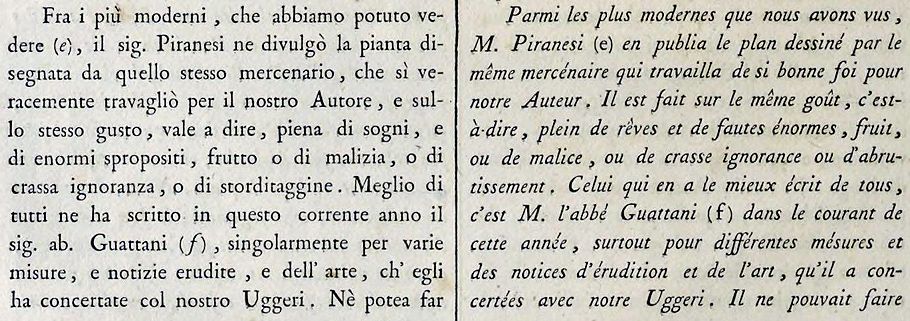
Among the most modern, which we have been able to see, Mr. Piranesi divulged the plan drawn by that same mercenary, who worked so sincerely for our Author, and in the same taste, that is to say, full of dreams, and of enormous blunders, fruit either of malice, or of crass ignorance, or of lightheadedness. Best of all, Mr. ab. Guattani, singularly for various measures, and erudite information, and of the art, which he has concerted with our Uggeri. [I still have to find out who this "same mercenary" is.]
Pierre-Adrien Pâris was the "same mercenary."
47 y.o. Francesco Piranesi 1805
Le Antichitŕ della Magna Grecia Parte II
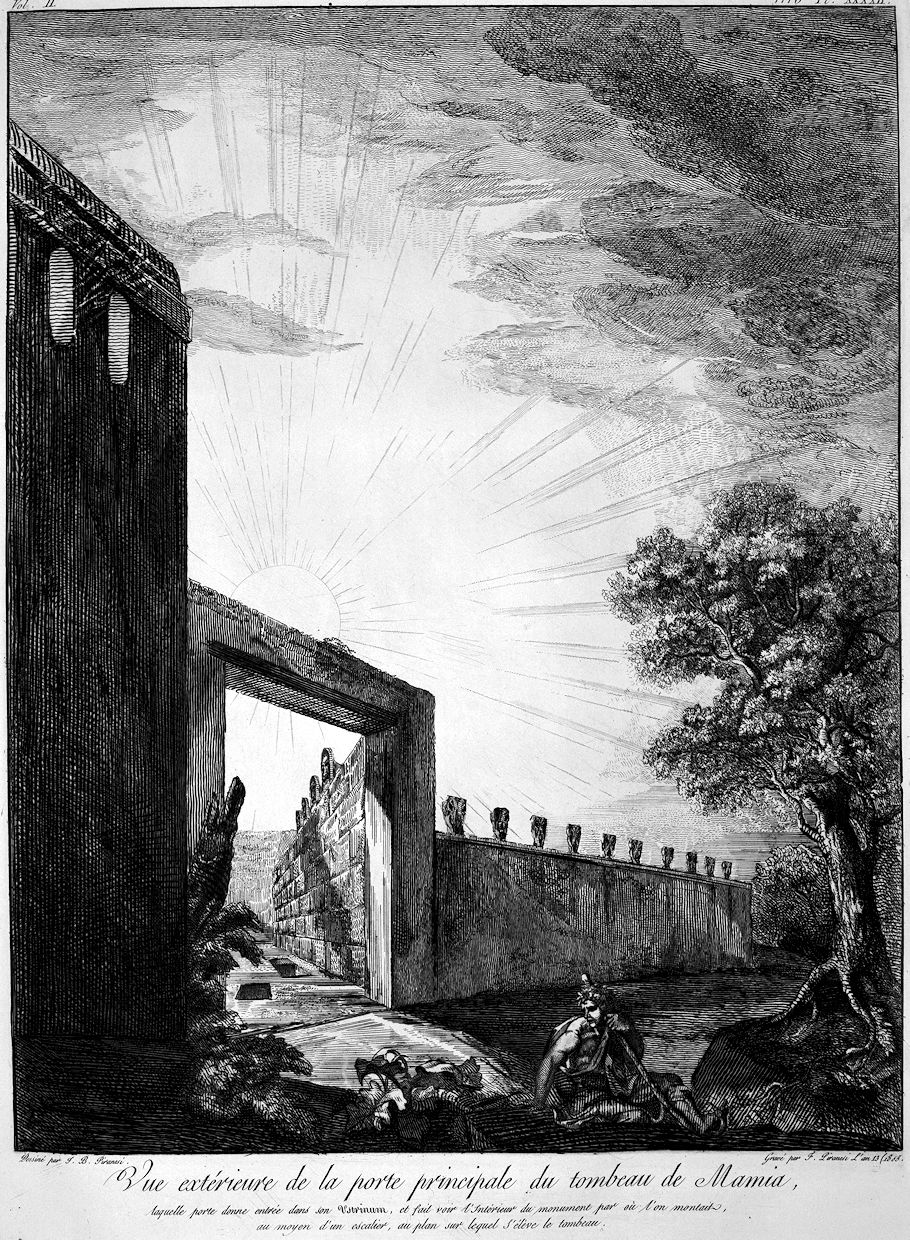
Exterior view of the main door of the tomb of Mamia, which door gives entrance to her Ustrinum, and shows the interior of the monument by which one ascended, by means of a staircase, to the plane on which the tomb.
Drawn by G.B. Piranesi
Engraved by F. Piranesi Year 13 (1805)
10 August 1812 Monday

Morning cloudy, wind SE to E, temperature about 72°. Small rain from passing clouds. Wind continued same way, temperature rose to 78°.
10 August 2008
Adam (sans Eve) in the Garden of Satire
August 10, 1977
...at Columbia University. I would have liked to split up except I had no watch. ...would have spent the day around Cooper-Hewitt and the Met (maybe also Cooper Union). ...apprehensive about the Rome trip in general and what the next three weeks will be like specifically.
Yesterday was such a nice day because it was nothing. It flowed by without time.
What will the others be like?
[flight scheduled to leave JFK 10:45 pm]
Adam (sans Eve) in the Garden of Satire
Piranesi's close familiarity with [Hadrian's] Villa dates back at least to the 1750s, when there are accounts of sketching expeditions made in the company of Robert Adam, Clérisseau and Allan Ramsay.*
--John Wilton-Ely, The Mind and Art of Giovanni Battista Piranesi (London: Thames and Hudson, 1978), p. 41
*See John Fleming, Robert Adam and his Circle in Edinburgh and Rome, London and New York, 1962, passim.
passim : here and there: used in bibliographic references to indicate that the writer has drawn upon material scattered throughout the source cited.
In fact, there is no direct evidence within Robert Adam and his Circle in Edinburgh and Rome that Piranesi and Adams were ever together at Hadrian's Villa, nor does Adam every mention Piranesi having been to Hadrian's Villa. Was perhaps Adam at Hadrian's Villa before Piranesi ever was? It is on record that Adam was at the Villa d'Este mid-June 1755. And again Adam led a survey and drawing expedition at Hadrian's Villa for six days in April 1756.
Many of the specifics we have today regarding Piranesi's life from June 1755 to late-April 1757 come from the coeval letters of Robert Adam. According to Wilton-Ely: The new decade of the 1760s saw a broadening of Piranesi's antiquarian concerns... A particular field of operation in this decade was Tivoli and the ruins of the nearby Hadrian's Villa.
Here and there indeed.
10 August 2017
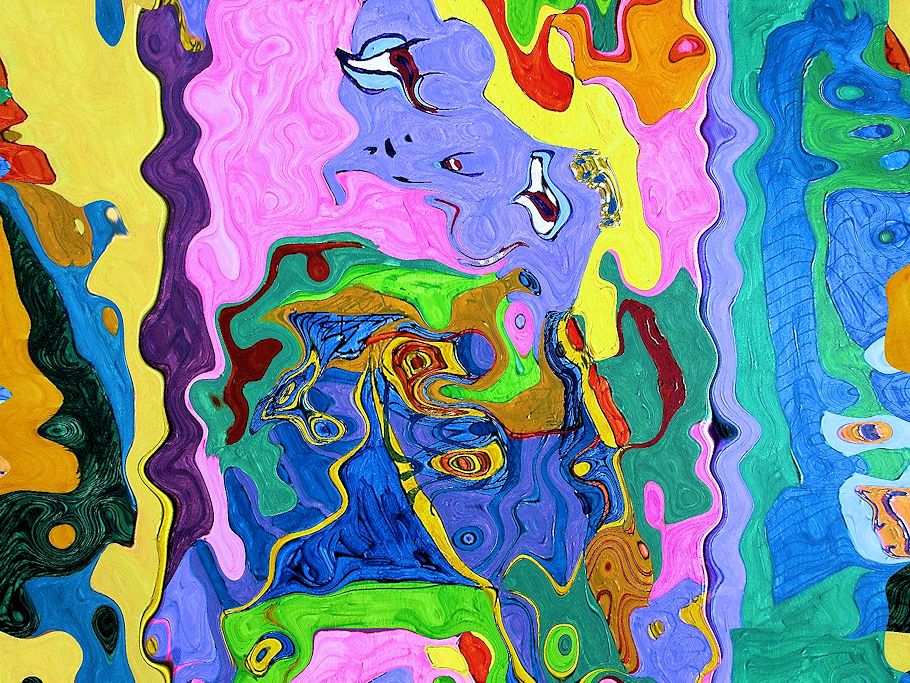
Virtual Painting 451
10 August 2023 Thursday
Lots of web research on Pierre-Adrien Pâris/Caracalla, with lots of new information found and yet to assimilated. I'll post here just one of the images found:
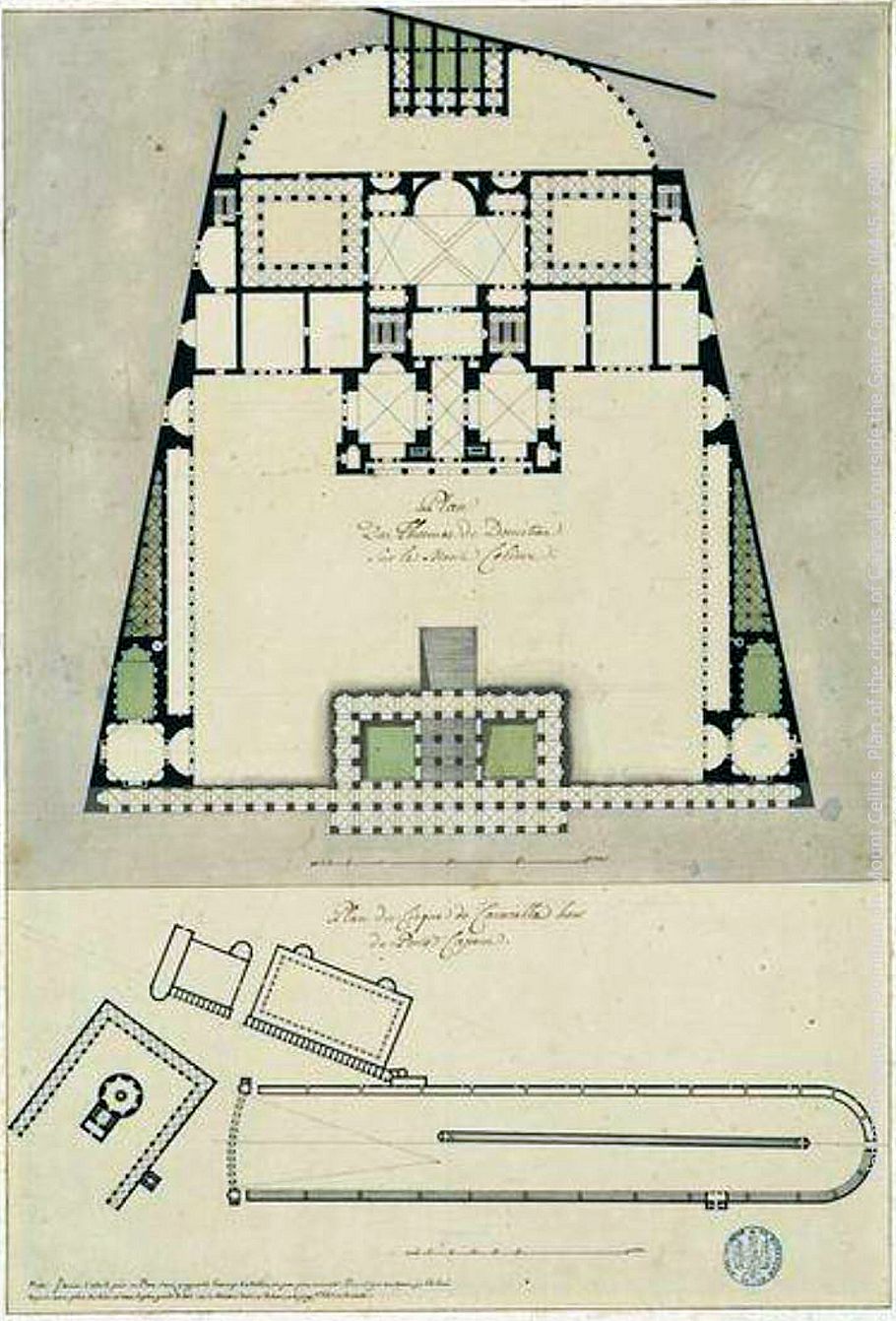
source
|